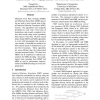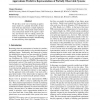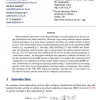723 search results - page 37 / 145 » Computationally Efficient Transductive Machines |
ACL
2009
13 years 5 months ago
2009
Minimum Error Rate Training (MERT) and Minimum Bayes-Risk (MBR) decoding are used in most current state-of-theart Statistical Machine Translation (SMT) systems. The algorithms wer...
ICML
2010
IEEE
13 years 5 months ago
2010
IEEE
We provide a novel view of learning an approximate model of a partially observable environment from data and present a simple implemenf the idea. The learned model abstracts away ...
COLT
2008
Springer
13 years 9 months ago
2008
Springer
Standard no-internal-regret (NIR) algorithms compute a fixed point of a matrix, and hence typically require O(n3 ) run time per round of learning, where n is the dimensionality of...
BMVC
2010
13 years 5 months ago
2010
Kernel methods yield state-of-the-art performance in certain applications such as image classification and object detection. However, large scale problems require machine learning...
CLUSTER
2003
IEEE
14 years 1 months ago
2003
IEEE
This paper presents an analysis of utilizing unused cycles on supercomputers through the use of many small jobs. What we call “interstitial computing,” is important to superco...



